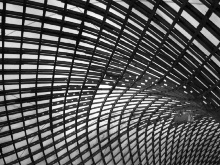Material Systems II / bend.IT
Behavioral simulation of elastic deformation in the computational design process
Bending, as a process of self-organization, is a material-dependent behavior. In an architectural context, it has been minimally exploited as a design parameter. Buildings whose design is based on the elastic deformation of a structure are known primarily through examples of grid-shells. Elastic deformation, as a formative method of design and construction, currently remains as a marginal phenomenon in the architecture.
The shape of structures subject to bending was initially determined through physical modeling. Studies from the 1960s became a basis for the development of the first digital form-finding algorithms. These algorithms, initially, were set up to confirm the physical model geometry. More advanced algorithms, such as dynamic relaxation, force-density, and finite element analysis, are now commonplace and may offer the potential to become integrated into the early stages of computational design processes.
As part of the studio, the behavior of bending will be embedded into the computational design process. The primary focus is the design of a pavilion for the forecourt of the K2 building at Stuttgart University. A design process will be developed which integrates experiments in physical form-finding with algorithms for the simulation and geometric representation of elastic deformation. The digital information model will include the main forces that drive the shaping of the forms, data for parametric dimensioning of the elements of the structure, and specifications for interfacing with computer-controlled manufacturing processes.


